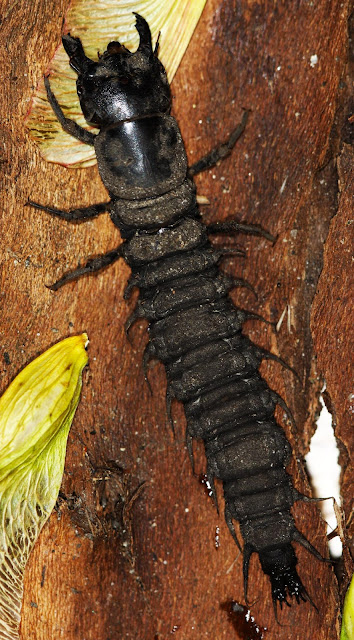Hellgramites are one of the largest and most agressive aquatic insects around. They are fierce predators in fresh water streams, rivers, and ponds here in Minnesota. They live for 3 or 4 years under water getting bigger and developing very bad attitudes.
But after their years in the water, about mid May, the older ones leave the water and begin to wander looking for a safe place to hide while changing into an adult insect.
The one in this picture is 4 inches long and was hard to get to sit still for a photograph. They move constantly, and bite hard when picked up. This one was found wandering across a gas station parking lot. It crawled around the cage I put it in for a week before it curled up and lay quietly for another week under a large piece of bark on some wood chips.
It has six true legs but appendages on each segment of it's abdoman look like additional legs. They are useless as legs, though. But notice the 4 "claws" on the tail end. It uses these to thrust itself backward very quickly, much like a crayfish.
Here you can see it's large and powerful jaws.
Last Friday night, after a week of quiet, it shed the black/brown larval skin and entered the pupae stage of its life.
I think it looks like a baby dragon about to emerge as an adult. You can see it already has the wings, the antennae, and the long legs that will be promenent as an adult Dobsonfly. I will post pictures of that after it emerges.
It twists and turns as if it is having dreams of an active adult life. When I took these pictures it used its jaw and body to try to push itself back under cover. It could move quickly.
And its jaws still work and look pretty mean as can be seen in the bottom picture.
This is a very cool insect that looks very different in its separate life stages. As you will see in a future post, the adult is not yellow, so why this color is present in the pupae is a mystery, especially after the larvae was so color blended with its habitat.





No comments:
Post a Comment